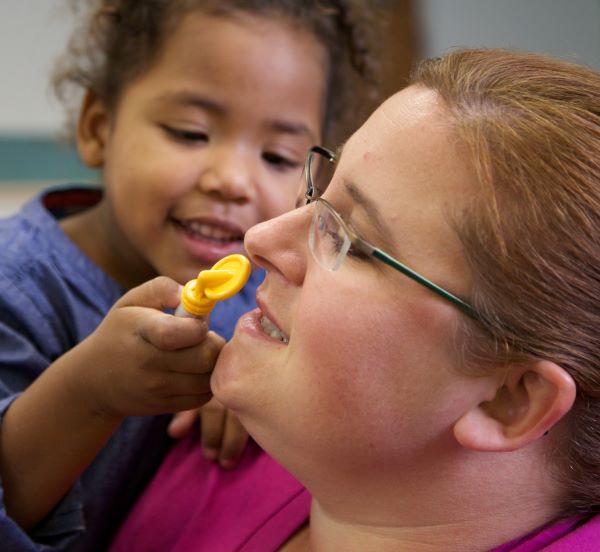 A healthy mouth is just as important for adults' overall health and well-being as it is for children. When adults have a healthy mouth, they can speak clearly, eat healthy foods, look healthy, and feel good about themselves.
A healthy mouth is just as important for adults' overall health and well-being as it is for children. When adults have a healthy mouth, they can speak clearly, eat healthy foods, look healthy, and feel good about themselves.
This Brush Up on Oral Health tip sheet talks about the impact of oral health on adults' overall health and well-being and offers tips on what Head Start staff can do to help adults keep their mouths healthy.
Oral Health and Overall Health and Well-Being
In addition to tooth decay, many adults have gingivitis or periodontal disease. Both are infections that affect the gums and bones that hold the teeth in the jaw. In most cases, these diseases occur when bacteria are not cleaned from the teeth and gums daily. Signs of gingivitis and periodontal disease may or may not be noticed.
Gingivitis is a common and mild form of periodontal disease. Signs of gingivitis can include red, swollen gums that bleed when brushing or flossing. Pregnant women often have gingivitis from hormone changes that make their gums more sensitive to bacteria. Brushing twice a day and flossing once a day usually reverses gingivitis.
Untreated gingivitis can spread into the bone that holds the teeth in the jaw. Bone loss around the teeth can occur in mild to moderate periodontal disease. Possible signs of mild to moderate periodontal disease include sensitive teeth, purple or receding gums, or teeth that look long. It is key to have ongoing care by an oral health professional to prevent more bone loss.
People with severe periodontal disease may notice pus in their gums, bad breath, and loose teeth. It is difficult to treat severe periodontal disease. Often these people lose many or all of their teeth.
In addition to saving a person's teeth, treating periodontal disease is important because the infection can affect a person's overall health by:
- Making it harder for people with diabetes to control their blood sugar. Also, people with diabetes are more likely to develop periodontal disease than those without diabetes
- Increasing risk for developing heart disease and possibly making existing heart disease worse
- Increasing risk for stroke
 What Head Start Staff Can Do to Promote a Healthy Mouth
What Head Start Staff Can Do to Promote a Healthy Mouth
The steps to keep a healthy mouth are simple. They include:
- Brush twice a day with fluoride toothpaste. Brushing in the morning and just before bed removes the bacteria that cause oral diseases. Use a soft bristled toothbrush and focus on the gums. Use a small amount of fluoride toothpaste and do not rinse after brushing so the fluoride has time to soak in and strengthen the teeth. For more information on brushing, see the How to Brush handout from the American Dental Association (ADA).
- Floss once a day. Flossing once a day removes the bacteria that cause periodontal disease from the sides of each tooth where a toothbrush cannot reach. Learning to floss can take time and practice. A dental hygienist or dentist can show you the best method and give feedback on how to improve your flossing. For more information on flossing, see ADA's How to Floss handout.
- Drink fluoridated water throughout the day. Fluoride in drinking water helps prevent tooth decay. Most bottled water does not contain fluoride.
- Avoid frequent snacking throughout the day. Snacking frequently during the day increases adults' risk of developing tooth decay. This is especially true if the snacks include foods and drinks with added sugars. For more information, see Brush Up on Oral Health: Understanding How Sugar Contributes to Tooth Decay.
- Visit the dental office/clinic regularly. Visiting the dental office/clinic on a regular basis allows the dental team to check for tooth decay and periodontal disease and develop a plan to help prevent or treat oral diseases. They also provide preventive care and oral hygiene education.
Download a PDF version to print and share.
Read more:
Resource Type: Article
National Centers: Health, Behavioral Health, and Safety
Audience: Teachers and Caregivers
Series: Brush Up on Oral Health (BUOH)
Last Updated: February 14, 2024
